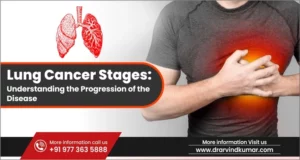The most common type of cancer that results in death is lung cancer. Lung cancer is no.1 cancer in males in India and is increasing rapidly in females as well . As fewer individuals smoke cigarettes and as lung cancer treatments advance, lung cancer rates, which had been rising for decades, are falling. Because of more cases of early diagnosis of lung cancer, when treatment is most effective, life expectancy after a lung cancer diagnosis has increased.
Understanding lung cancer better enables you to feel more in charge of your health and contribute to the education of others.Incidence of Lung Cancers burden of disease is rising globally. The decrease is seen only in America where awareness has reduced the incidence. Let us continue reading to find out more about lung cancer, why early lung cancer detection is important when to get a lung cancer diagnostic test, and what is life expectancy after a lung cancer diagnosis
What is Lung Cancer?
Cancer is a condition in which the bodys cells grow unchecked. Lung cancer is a type of cancer that starts in the lungs and can then metastasize to other parts of the body.
Beginning in the lungs, lung cancer has the potential to spread to the lymph nodes or other bodily organs, including the brain. The lungs may potentially become infected with cancer from other organs. Metastases are those cancer cells that have migrated from one organ to others. The majority of the time, lung cancer is a result of breathing in hazardous chemicals. However, even those without a history of exposure to harmful substances can develop lung cancer.
Cancer cells develop uncontrollably and collect to form tumors, which kill the healthy lung tissue around them, in contrast to normal cells. Typically, symptoms do not occur until cancer cells have moved to other organs and interfered with their ability to function. Lung cancer treatment is more difficult at this stage.
Small cell and non-small cell lung cancers are the two primary subtypes that are typically recognized (including adenocarcinoma and squamous cell carcinoma). These distinct forms of lung cancer develop differently and respond to various treatments.
Small Cell Lung Cancer (SCLC)
Small Cell Lung Cancer comprises 10-15% of Lung Cancers. It is also sometimes called oat cell cancer. This type of cancer tends to grow fast and spread to other organs of the body and hence usually discovers at a late stage.
Non-Small Cell Lung Cancer (NSCLC)
More people develop non-small cell lung cancer. About 80% of cases of lung cancer are caused by it. Compared to small cell lung cancer, this type of cancer typically develops and metastasizes to other parts of the body more gradually.
The three kinds of non-small cell lung cancer are as follows:
Adenocarcinoma: A type of non-small cell lung cancer that frequently affects the lungs periphery. It grows in the epithelial tissues that border the bodys cavities and surfaces and give glands their shape.
Squamous cell carcinoma: Non-small cell lung cancer known as squamous cell carcinoma is typically discovered in the lungs middle, close to an air tube (bronchus).
Large cell carcinoma: Non-small cell lung cancer that can develop in any section of the lung and has a tendency to grow and spread more quickly than adenocarcinoma or squamous cell carcinoma is known as large cell carcinoma.
The aforementioned subtypes are the most prevalent, although a tumor from a lung cancer patient may show additional details about the subtype when examined under a microscope.
Factors that increase the risk of lung cancer
Your chance of getting a lung cancer diagnosis may be impacted by several variables. Lung cancer risk factors include
Smoking– The number of cigarettes you smoke each day and the length of time you have been smoking both raise your risk of developing lung cancer. Quitting at any age can drastically lessen your risk of developing lung cancer.
Exposure to passive smoking- Even if you don smoke, being around secondhand smoke raises your risk of developing lung cancer.
Prior radiation treatment- You may be at a higher risk of developing lung cancer if youve had chest radiation therapy for another type of cancer.
Being exposed to radon gas- The natural breakdown of uranium in soil, rock, and water results in the production of radon, which eventually finds its way into the air you breathe. Radon can build up to unsafe levels in any building structure.
Exposure to other carcinogens, such as asbestos- Your chance of developing lung cancer can increase if you work with asbestos and other cancer-causing agents including arsenic, chromium, and nickel, especially if you smoke.
History of lung cancer in the family- Lung cancer risk is higher in people who have a parent, sibling, or child who has the disease.
What lung cancer stages are there?
The size of the initial tumor, how deeply it penetrates the surrounding tissue, and whether it has migrated to the lymph nodes or other organs are the main factors used to stage cancer. There are specific staging recommendations for each form of cancer.
Staging of lung cancer
There are some possible size and spread combinations at each level. For instance, a Stage III cancer may have a smaller initial tumor than a Stage II cancer, but additional variables may have advanced cancer to a more serious stage. The general lung cancer staging is as follows:
Stage 0 (in-situ): The top layer of the lung or bronchus has cancer. It hasn spread to the outside or other lung tissue.
Stage I: Cancer has not left the lung.
Stage II: Cancer that is greater than Stage I, has spread to internal lymph nodes, or has many tumors in the same lung lobe.
Stage III describes cancer that is more advanced than Stage II, has spread to neighboring lymph nodes or structures, or has multiple tumors in distinct lobes of the same lung.
Stage IV: The other lung, surrounding fluid, or other distant organs have all been affected by cancer.
Stage: limited vs. extensive
Although lung cancer doctor in India now refer to small cell lung cancer as being in stages I through IV, you may also hear the terms restricted or extensive stage used. Whether the area can be treated with a single radiation field will determine this.
The lymph nodes in the middle of the chest or above the collar bone on the same side are occasionally involved in limited-stage SCLC, which is localized to one lung.
The lymph nodes on the opposing side of the lung, the other lung, or other body regions have all been affected by extensive stage SCLC, which has spread across one lung.
What symptoms would lung cancer have?
The majority of lung cancer symptoms resemble those of other, less dangerous conditions. Many people don have symptoms until the condition has progressed, but other people do. One or a couple of these symptoms may be all that people who do suffer symptoms have:
- A persistent cough that becomes worse with time.
- Shortness of breath or breathing difficulties (dyspnea).
- Chest discomfort or pain
- Wheezing.
- Coughing out blood (hemoptysis).
- Hoarseness.
- Decrease in appetite.
- Unexplained weight loss
- Undue fatigue (tiredness).
- Shoulders pain.
- Superior vena cava syndrome (swelling of upper chest, neck, face, or arms).
- Some patients develop small pupils and drooping eyelids in one eye, with decreased facial sweating due to Horner’s Syndrome.
Why is Early Diagnosis of Lung Cancer Important?
Some of the symptoms of lung cancer may appear early (in stages I or II) depending on where your lung cancer first appears, but they frequently don until the disease has advanced to a more advanced stage. That’s why it’s crucial to get screened for lung cancer if you’re at higher risk as early diagnosis of lung cancer can significantly improve life expectancy after a lung cancer diagnosis.
Early diagnosis of lung cancer is the key to improving lung cancer patient survival rates. Early diagnosis of lung cancer can prevent lung cancer-related deaths as more than half of people die within one year of being diagnosed with lung cancer. Although lung cancer is frequent, many people are unaware of it or are frightened to find out more.
Because symptoms usually do not manifest until cancer has spread, lung cancer can be misdiagnosed for a long period. Many individuals are in severe stages before they are detected since there are no early warning of symptoms. You may be eligible for a lung cancer detection screening if you are over 55 and have a history of smoking.
Lung Cancer Diagnosis by age
Despite the fact that lung cancer primarily affects those over 60, it can sometimes be found in younger patients. The risk of lung cancer can be influenced by a number of variables, many of which interact with age.
It is more likely for older persons to develop lung cancer. A very tiny percentage of lung cancer diagnoses occur in patients under the age of 45, with most patients being 60 or older. When given a Lung cancer diagnosis, typically a person is around 70 years old. However, there is a recent trend of Lung Cancer appearing more and more in the younger population also.
Diagnostic evaluation of lung cancer
A lung cancer diagnosis is a multi-step process. Your lung cancer diagnosis would typically involve more lung cancer diagnostic tests to identify it. Your doctor may ask you to get the following lung cancer diagnostic test:
- Computerized Tomography Scan (CT Scan)
- Positron Emission Tomography (PET Scan)
- Magnetic Resonance Imaging (MRI) of the brain
- Chest X-ray
- Bronchoscopy
- Fine-Needle Aspiration
- Biopsy
- EndoBronchial Ultrasound (EBUS)
- Sputum Cytology
- Bone Scans
- Perfusion Lung Scans
- Blood Tests
- Breathing Tests
- Pulmonary Function Test (PFT)
- Thoracotomy
- Mediastinoscopy
Lung Cancer Treatment
Lung cancer diagnosis and treatment come hand in hand as the sooner the treatment starts the better are the chances of survival. Your doctors will present you with one or a combination of the following treatments:
Surgery- is an option for NSCLC that hasn spread and SCLC that is diagnosed at a very early stage. The surgery to remove the required portion of lung can be performed by Conventional Open technique or by Video Assisted Thoracoscopic Surgery which allow for Lung Cancer surgery through key-hole method. The type of Lung cancer surgery may range from segmentectomy, lobectomy, wedge resections to Pneumonectomy (removal of entire lung) depending upon the size and location of the tumor.
Robotic-Assisted Thoracic Surgery: Robotic thoracic surgery is a form of the cutting-edge, minimally invasive surgical procedure utilized in thoracic surgeries for select lung cancer cases. It can be used to remove damaged lung tissue and possibly adjacent lymph nodes. It offers advantages in terms of less pain and complications and faster recovery.
Radiation therapy- High-energy beams are used in radiation therapy to eliminate cancer cells. It can be utilized both independently and to boost surgical effectiveness. In palliative care, radiation can be used to reduce tumor size and lessen pain. Both NSCLC and SCLC use it. It is frequently used with chemotherapy for better clinical outcomes.
Radiofrequency ablation: This procedure is occasionally used to treat NSCLC tumors that are close to the borders of your lungs (RFA). In RFA, heat is used to kill cancer cells by using High-energy radio waves.
Chemotherapy- is frequently a mix of many drugs intended to inhibit the spread of cancer cells. It may be used before, following, or in conjunction with the use of other medications, such as immunotherapy. Usually, lung cancer patients receive their chemotherapy through an IV.
Targeted drug therapy – In some people with NSCLC, lung cancer cells have specific changes (mutations) that help cancer grow. This type of cancer treatment uses medications that are specifically formulated to attack the patients cancer-related genes, proteins, or tissue environment. These factors affect cancers ability to grow and survive and help fight the cancer with minimal effect on normal lung tissue.
Immunotherapy- Normally, our bodies identify damaged or dangerous cells and eliminate them. To avoid being eliminated, cancer hides from the immune system. Immunotherapy enables your body to fight cancer on its own.
Life expectancy after lung cancer diagnosis
The five-year survival rate for lung cancer is 18.6%, which is lower than the rates for many other common cancers. For cases of lung cancer found while the disease is still localized, the five-year survival rate is 56%. (within the lungs). Only 16% of lung cancer cases, however, receive an early diagnosis.
However, By detecting the disease at an earlier stage when it is more likely to be treatable, screening for people at high risk has the potential to significantly increase life expectancy after a lung cancer diagnosis. Thousands of lung cancer deaths can be avoided if half of the high-risk people had screening.
Conclusion
A diagnosis of lung cancer can trigger a wide range of feelings. Overwhelming amounts of fresh information can occasionally occur. Its crucial to keep in mind that statistics cannot predict how your treatment will proceed or the best course of action for your particular circumstances.
You may find it helpful to weigh your options and express your views if you enlist the aid of dependable family members or a support group. Taking care of yourself is one of the most crucial aspects of cancer treatment because it is frequently a process.
Frequently Asked Questions
Can someone who does not smoke have lung cancer?
Although smoking is the main cause of lung cancer, up to 20% of those who are diagnosed have never smoked. Therefore, its crucial to discuss any concerning symptoms with your doctor.

.webp)



